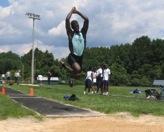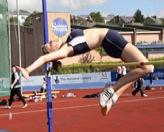Jumping
After training hard, these two children have improved their results. Can you work out the length or height of their first jumps?
Problem

Ben is hoping to enter the long jump at his school sports day.
One day I saw him manage quite a good jump.
However, after practising several days a week he finds that he can jump half as far again as he did before.
This last jump was $3.75$ metres long.
So how long was the first jump that I saw?

Now Mia has been practising for the high jump.
I saw that she managed a fairly good jump, but after training hard, she managed to jump half as high again as she did before.
This last jump was $1.20$ metres.
So how high was the first jump that I saw?
How did you work these out?
Can you find any other ways of finding a solution?
Which way do you prefer? Why?
Getting Started
Use anything that you like to help you - pictures, number lines, a whiteboard for jottings ...
Is your answer sensible? Does it seem about the right size?
Student Solutions
We had a large number of solutions sent in and most of them were correct.
Baston, Midgley, Longcroft and Montgomerie Schools sent in many solutions. Here are some explanations that showed some good thinking.
The Maths Challenge Club from St Aidan's Primary sent in the following:
Isobel used a trial and error method:
$200 \times 1.5 = 300$ no- too small
$300 \times 1.5 = 450$ no- too big
$250 \times 1.5 = 375$ yes!
So the first jump was $250$cm
She used a trial and error method for the second question too:
$10+10+10= 30$ no- too small
$20+20+20=60$ no- too small
$30+30+30=90$ no, still too small
$40+40+40=120$ yes!
So the first jump was $40+40=80$cm
Jamila got the same answer, but used a different method:
$3.75 \div 2 = 1.875$
$1.875 \div 3 = 0.625$
$1.875 + 0.625 = 2.500$ or $2.5$m
$(a\div2) + (a\div6)$
She used the same method for the second question:
$(a\div3) \times 2$ where $a=120$cm = $80$cm
Holly and Chris from Myland School in England sent in this thorough explanation;
We worked out that Ben's first jump was $250$cm and Mia's first jump was $80$cm. We used division, multiplication, and addition to solve the problem.
First we halved the last jump number. Mia's last jump was $120$cm, half of that is $60$cm. We halved the number then added on the half. That would mean that Mia's last jump was $90$cm, which wasn't right.
We used a trial and improvement method. We chose round even numbers because it was much easier to find half. If the last jump worked out as $75$cm less than what we needed then we added $75$cm to the first jump number and tried again. Example - If the 1st jump was $200$cm the last jump would be $300$cm so we tried - If the 1st jump $275$cm then the last jump would be $412.5$cm That didn't work but it did get us closer to the answer. As $275$cm was too high, we tried $260$cm, then $250$cm.
We tried our own standing long jumps. Our best scores were:
Holly $110$cm Jordan $143$cm
If we improved our scores by half again that would be:
Holly $165$cm Jordan $214.5$cm
If we improved our scores by a quarter again that would be:
Holly $137.5$cm Jordan $178.75$cm
We folded the tape measure to help us work out a half and a quarter of different lengths.
Finally, Daniel from King's School New Zealand said:
Ben's last jump was $3.75$ metres long.
$3.75 = f + \frac{f}{2}$
$f$ = Ben's 1st jump
You need to find the value of $f$.
So $3.75 \div 3 = 1.25$
$1.5f \div 3 = \frac{f}{2}$
$\frac{f}{2} \times 2 = f$
$1.25 \times 2 = 2.5$
$f = 2.5$
Ben's first jump was $2.5$ metres
Mia's last jump was $1.20$ metres high.
$1.20 = f + \frac{f}{2}$
$f$ = Mia's first jump
You need to find the value of $f$.
So $1.20 \div 3 = 0.40$
$\frac{1.5f}{3} = \frac{f}{2}$
$\frac{f}{2} \times 2 = f$
$0.40 \times 2 = 0.80$
$f = 0.80$
Mia's first jump was $0.80$ metres high.
Well done all of you, and thanks for those contributions sent in.
Teachers' Resources
Why do this problem?
Possible approach
Key questions
Possible extension
Possible support
